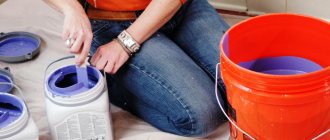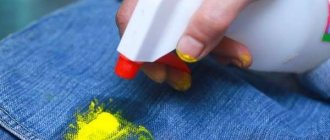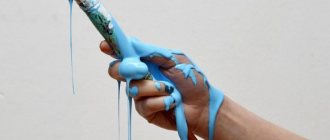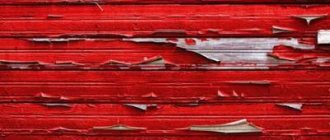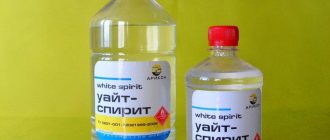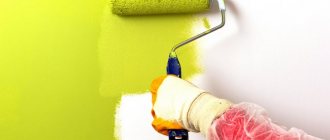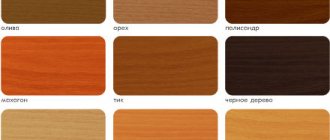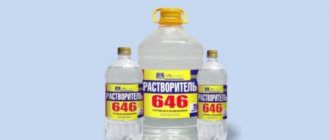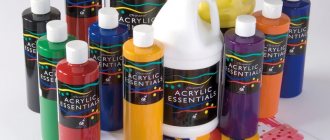Instructions on how to properly dilute paint
Paint that has become thick, dense and heavy over time will have poor adhesion to the surface during use.
- Its consistency becomes lumpy, and this will not allow you to get an even, beautiful coating.
- Otherwise, applying such paint will be quite problematic, and over time it will completely fall off the wall surface.
- To prevent this from happening, and to ensure that the work progresses easily and quickly, the paint must be diluted before use.
When diluting the material, it is very important not to overdo it, otherwise it will lose its elasticity and become too liquid. In addition, the paint will take a long time to dry, its coating will be sticky and short-lived. As a result, both the material and the surface will be hopelessly damaged.
Oil application technologies
There are three ways to paint wood with oil:
- Vacuum impregnation. This technique is usually used in industrial settings. Such processing requires special equipment, so it is impossible to cover the surface using this technology yourself.
- Soaking. The method involves placing the wood in heated oil, letting it sit for a certain amount of time, and then drying it. Only small wooden products can be painted in this way.
- Layer coating. This technology is the most common. It is used for processing wooden surfaces of various sizes. This method is discussed in detail below.
The oil can be applied cold or hot. Application rules are the same for both options. The difference is in the oil impregnation temperature. In the first case, use oil at room temperature, in the second, the composition is heated to a temperature of 80 degrees before use. It is also necessary to warm up the surface itself with a special thermal pad, since it will not be possible to saturate cold wood with hot oil; the product will not be able to be absorbed and will remain on the surface.
Regardless of the chosen method, you need to paint wood with oil in stages:
- First, the first layer of impregnation is applied. The oil is applied with a brush or cotton cloth in a thin layer and distributed evenly over the surface.
- Excess oil must be removed immediately; if this is not done, the impregnation will dry out and form a crust, which will then be very difficult to remove. To remove excess oil, you need to wipe the area with a dry cloth. You need to rub in the impregnation until the rag collects the oil. If the oil is not absorbed and is lying on the surface of the floor, you can take a rubber spatula and use it to scrape the excess into puddles, and then collect it with a rag.
- Next, the surface is polished with a soft cloth. After this, wipe all wet areas dry with a cotton rag.
- With the cold processing method, the application of the second layer begins no earlier than 5 hours; in some cases it is necessary to wait up to 12 hours. It depends on the type of oil. The second treatment with hot oil can be done after 2-2.5 hours, because it dries much faster.
- Repeated processing is carried out similarly to the first, each layer must be sanded. The number of layers depends on the condition of the surface, wood species and type of oil. Usually 2-3 layers of treatment are enough.
It takes two to three weeks for the surface to completely dry; the exact period depends on the combination of the factors listed above.
Applying oil to the facade of a house made of timber and logs should be done in warm sunny weather. It is advisable to prime the surface before doing this. Let's take linseed oil as an example. If the processing is carried out with flax oil, it must first be cleared of impurities, since under the influence of solar radiation the flax impregnation turns yellow.
Methods for purifying oil:
- Using regular saline solution. To achieve a good result, the oil must be washed at least 5-7 times.
- Mix the oil with lead salt and heat the composition to 60 degrees.
- Adding ethanol.
- Photooxidation. The oil is boiled with water, filtered and kept in the light.
Impregnation application process:
- We remove the old coating.
- We polish the surface.
- We remove dust with a vacuum cleaner.
- Using a brush with soft bristles, apply the first layer of oil-turpentine impregnation.
- After drying, sand the surface and apply oil again.
- After final drying, we process the wood a third time.
In what cases is it necessary to thin the paint?
During long-term storage, the material can thicken even in a tightly closed container, and even more so if it was stored open. This paint cannot be applied with a roller or brush.
If the paint is applied unevenly, rolls off, forms sagging and brush marks, then it must be diluted.
If work is performed on large surfaces, the paint can be diluted, thereby increasing its volume. When thinning the paint, it is important to monitor its viscosity and not allow the consistency to become too runny.
How to dilute paint (types of solvents)
There are special tools that help achieve the desired consistency of the material.
They differ in evaporation rate:
- Universal. These include compositions suitable for various paints. Suitable for work at any time of the year.
- Evaporates quickly. Such thinners help the paint dry quickly, which allows you to work with paint at low temperatures in the autumn-winter period.
- Slowly evaporating. Suitable for the hot season. Thanks to its low volatility, the paint becomes elastic, making it easy and pleasant to work with.
Thinners also differ in chemical properties:
- Hydrocarbon-based thinner: gasoline, kerosene, White Spirit and others;
- Thinners containing xylene, toluene, alcohols, ketones and ethers.
Solvent properties
Turpentine has a strong specific odor because it contains pine resin. For this reason, it should be used outdoors.
- White spirit preserves the original paint color and elasticity. It functions as both a paint thinner and a solvent, so it is convenient to clean the tool after work.
- Solvent 647 contains chemical components, which is why it has a strong, persistent odor. When working with it, you must ensure good ventilation. To achieve good paint uniformity, you need to mix it thoroughly.
- Gasoline and kerosene are a budget diluent option and have a simple composition. But at the same time, they are toxic flammable materials that require precise mixing proportions with paint.
- Drying oil is an oil-based thinner. Suitable for any type of paint. Together with paint it gives a durable and elastic coating.
- Water is suitable as a solvent for water-based paints.
Tee recipe
Experienced artists prefer to prepare their own thinner for oil paints, taking into account their needs. The most common “tee” recipe includes the following components:
- pictorial varnish (it is better to choose dammar or mastic);
- hemp, linseed or poppy oil (the latter is considered one of the most transparent and pure);
- turpentine or solvent for artistic oil paints (white spirit is most often used).
All components are mixed in a clean glass container in equal proportions. The container must be tightly closed, otherwise the solvent will begin to evaporate and lose its properties.
How much solvent is needed
All manufactured paints differ in their composition, which is why there is no specific dilution measure.
But manufacturers recommend diluting no more than 5%. This is equivalent to the scheme: 50 milliliters per 1 liter of paint.
How to properly dilute paint
To work, you will need a rectangular container. It is more convenient to dilute and mix paint.
It is important that the container has a streamlined shape, because material can accumulate in the corners, resulting in a heterogeneous mass.
- It is necessary to prepare a measuring cup with clear measuring markings.
- Next, mix the paint thoroughly; you can use a wooden spatula for this.
- Pour in the thinner in a thin stream, while simultaneously stirring the material, and evaluate the resulting consistency.
- If it has a moderately viscous and fluid composition, then the paint is ready for use.
Turpentine and white spirit
Purified turpentine is a good option for large-scale paintings. Oil paints for painting become quite viscous and do not dry for a long time, and therefore you will always have the opportunity to make adjustments to the work. However, never use household turpentine, only from an art store. This substance can make the paint appear yellow. As for mineral white spirit, it dries much faster than the previous substance. In addition, it is less finicky in storage and safer in terms of chemical composition. And the price of such a thinner is lower. However, if the substance is of poor quality, a white coating may appear on the finished work after drying.
Useful tips from a painter
After opening the container, the paint must be thoroughly mixed and then its condition must be assessed. During storage, it could separate, thicken and clump, and some of its components could sink to the bottom.
- Before you start thinning the paint, it is important to check its components for compatibility in order to avoid oxidation of the material. To do this, pour a little paint into a tray and dilute it with the chosen product. If the material has curled, it should not be used.
- It is better to prepare a small amount of material, this will help you not make mistakes in the calculations and not spoil the material.
- When working with solvents, you should take safety precautions; for this you need to use safety glasses, gloves, a respirator and work clothes. Good ventilation in the room will also be required, since these products are toxic and can adversely affect human health.
- Over time, the paint may thicken again, in which case the solvent can be used again.
- Paint that has dried and become as strong as stone should be diluted with the necessary product and left for two to three days. After this, mix thoroughly and evaluate its condition. If the paint has become more viscous and viscous, then it can be used to cover surfaces: greenhouses, garages, workshops, etc.
Thinning paint is a simple, but quite responsible process. It is important to monitor the consistency and strictly adhere to the manufacturer's recommendations.
Do not forget about safety measures, as toxic fumes from paint and thinners can negatively affect human health.
Can the thinner be reused?
Quite often, artists dip brushes stained with paint into a container of solvent. As a result, it becomes cloudy and, at first glance, absolutely unusable. Dirty diluent can be reused if filtered. First, let the liquid stand until sediment settles out, then pass it through a paper filter. The procedure must be repeated until the precipitate stops falling. Pour the filtered diluent into a clean glass container and screw the lid on tightly.
The right thinner for oil paints will make your work more vibrant and will also speed up the drying process.
